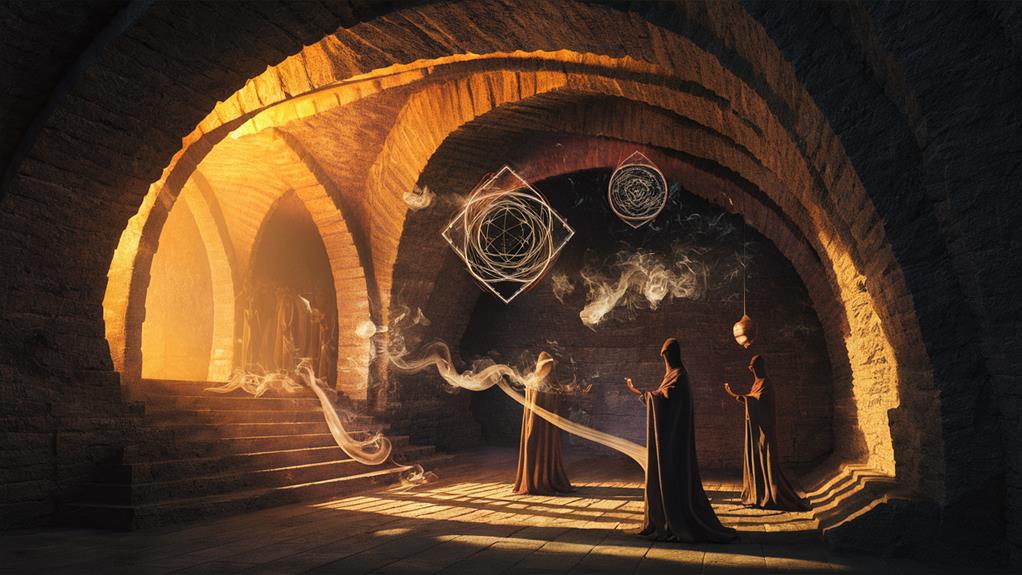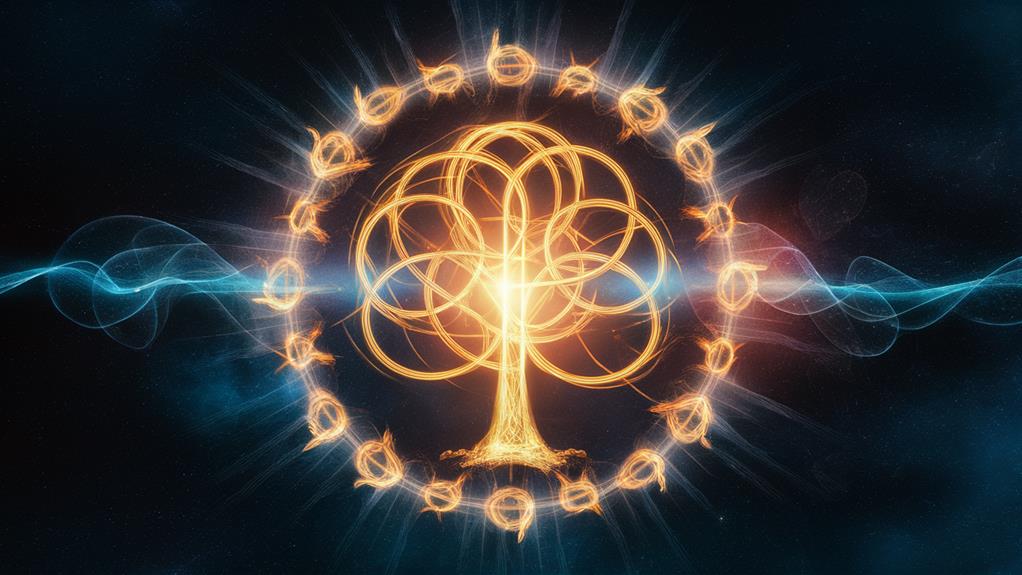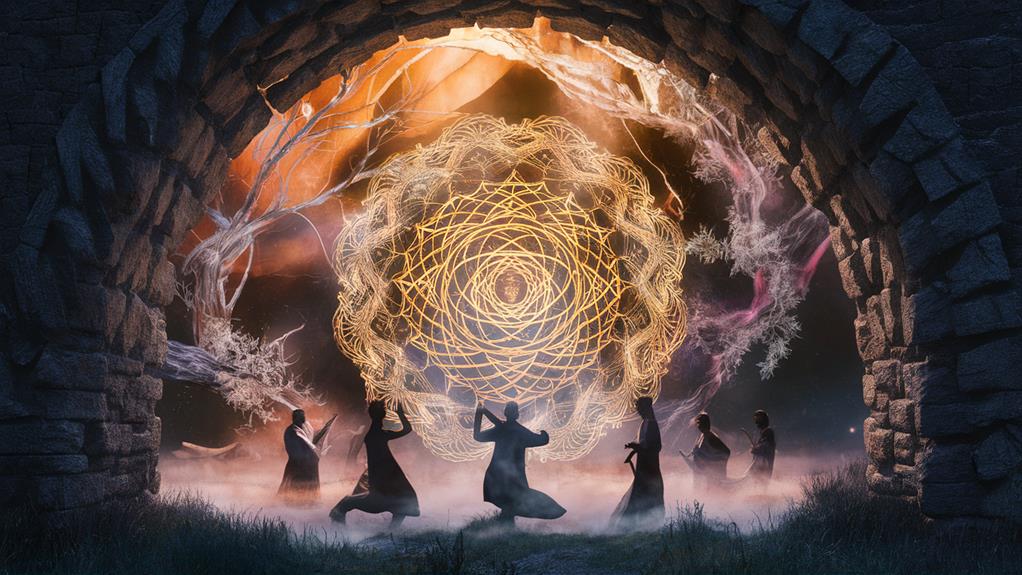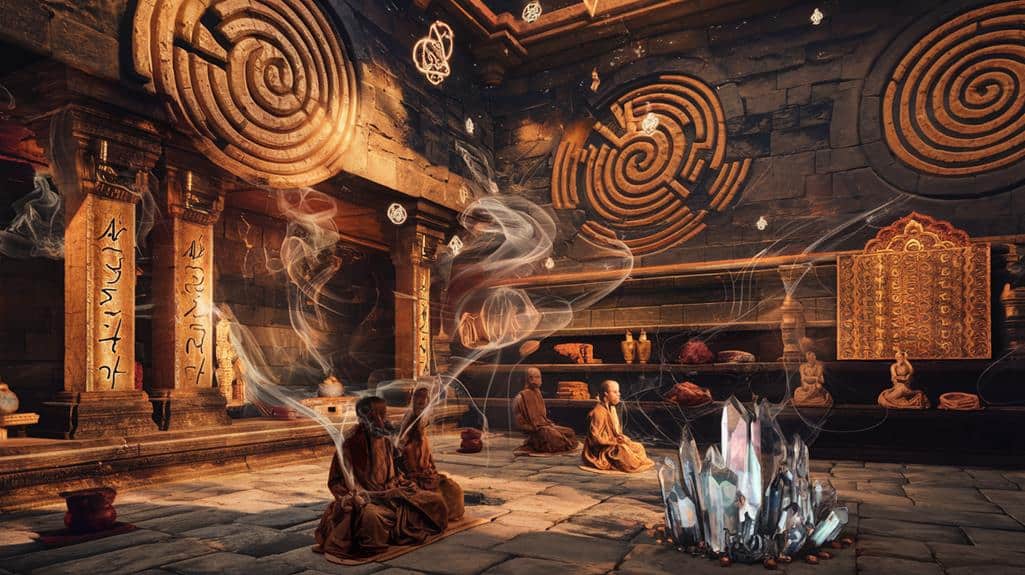Mystical Traditions Within Major World Religions (E.G., Sufism, Kabbalah, Christian Mysticism)
You’ve likely encountered references to mystical traditions in various contexts, but understanding their true essence requires looking beyond popular misconceptions. While mainstream religious practices focus on established rituals and communal worship, mystical paths like Sufism, Kabbalah, and Christian mysticism offer intimate, transformative approaches to experiencing the divine. These ancient traditions don’t just present theoretical frameworks—they provide practical methods for transcending ordinary consciousness and accessing deeper spiritual truths. As you explore these paths, you’ll discover how their timeless wisdom continues to illuminate contemporary spiritual seekers’ journeys toward ultimate reality.
Origins of Religious Mysticism

Seekers throughout history have searched for direct, personal experiences with the divine. You’ll find these mystical origins emerging across cultures, often in moments of profound spiritual awakening when individuals yearned to transcend ordinary consciousness and touch something greater than themselves.
Within ancient civilizations, you’ll discover the first traces of mystical practices in shamanic rituals, where practitioners bridged the physical and spiritual domains. As organized religions developed, these primal experiences evolved into more structured forms of mystical pursuit.
You’re connecting to an ageless tradition when you explore how Egyptian mystery schools, Hindu yogic practices, and Greek mystery cults all sought to reveal divine truths through direct experience rather than doctrine.
What’s fascinating is how these early mystics developed similar techniques across vastly different cultures – meditation, fasting, contemplative prayer, and sacred rituals. They understood that you can’t merely study the divine; you must experience it.
These pioneering spiritual explorers laid the groundwork for later mystical traditions like Sufism, Kabbalah, and Christian mysticism, creating paths that you can still walk today in your own search for transcendent truth.
Sufism and Islamic Mystical Practices
Within Islam’s rich spiritual landscape, Sufism emerged as one of the world’s most profound mystical traditions, carrying forward the ancient human quest for divine connection.
You’ll find that Sufis seek a direct, experiential relationship with the Divine through practices like dhikr (remembrance), meditation, and whirling ceremonies that transcend ordinary consciousness.
At Sufism’s core, you’ll discover the concept of fana – the dissolution of the ego to achieve union with Allah.
This path isn’t merely theoretical; it’s deeply practical, demanding rigorous self-examination and spiritual discipline.
You’re invited to explore practices that include sacred poetry, musical gatherings called sama, and the guidance of spiritual teachers known as sheikhs or murshids.
When you investigate Sufi teachings, you’ll encounter profound metaphors: the heart as a mirror that must be polished, love as the force that moves the cosmos, and the spiritual journey as a never-ending ascent.
The tradition’s greatest mystics, like Rumi and Ibn Arabi, have left you a legacy of writings that illuminate the path to divine knowledge through direct experience rather than intellectual understanding alone.
The Essence of Kabbalah

Throughout centuries of Jewish mystical thought, Kabbalah has stood as an esoteric tradition exploring the profound mysteries of creation, divinity, and human consciousness.
You’ll discover that at its core, Kabbalah seeks to understand the nature of God through the concept of Ein Sof – the infinite, unknowable divine essence – and its manifestation through ten emanations called Sefirot, which serve as channels of creative force flowing into our reality.
As you explore deeper into Kabbalistic wisdom, you’ll encounter the Tree of Life, a central symbol that maps the relationship between the infinite and the finite, illustrating how divine energy descends through various spiritual domains.
This sacred knowledge isn’t meant to remain purely theoretical; it’s a transformative path that can help you understand your role in the cosmic order.
You’ll learn that every human action reverberates through multiple layers of reality, affecting both the material and spiritual worlds.
Through meditation, study of sacred texts, and contemplative practices, you’ll discover how to align yourself with divine will, ultimately working toward Tikkun Olam – the repair and perfection of the world through conscious, purposeful living.
Christian Mystics Through Time
The rich legacy of Christian mysticism spans nearly two millennia, featuring profound spiritual seekers who’ve devoted their lives to direct communion with God.
You’ll find these mystics emerging throughout history, from the desert fathers and mothers of early Christianity to medieval luminaries like Meister Eckhart and Julian of Norwich.
When you explore the writings of these mystics, you’ll discover they share common themes: the transformative power of divine love, the pursuit of union with the Divine, and the paradoxical nature of spiritual truth.
Consider Hildegard of Bingen‘s vivid visions, Teresa of Ávila’s “interior castle,” or John of the Cross’s “dark night of the soul” – each offering unique pathways to transcendent experience.
In more recent centuries, you’ll encounter mystics like Thomas Merton and Simone Weil, who’ve bridged ancient wisdom with modern sensibilities.
They’ve shown how contemplative practices can pierce through the noise of contemporary life, leading you to deeper spiritual awareness.
Their experiences suggest that mystical communion isn’t confined to medieval monasteries but remains accessible to those who seek it, regardless of time or circumstance.
Common Threads Among Mystical Paths

While Christian mystics embody unique paths to divine communion, their experiences mirror striking parallels found in mystical traditions worldwide.
You’ll discover that whether you’re exploring Sufism, Kabbalah, or Buddhist meditation, certain fundamental themes emerge: the quest for direct experience of ultimate reality, the transcendence of ego, and the dissolution of boundaries between self and the divine.
These traditions share common practices you’ll recognize: the cultivation of silence, the importance of spiritual guides, and the use of contemplative techniques to quiet the mind.
You’ll find that mystics across cultures speak of similar stages in their spiritual journeys – from initial awakening through periods of darkness to eventual illumination.
They’ve described comparable states of consciousness: the feeling of unity with all existence, ineffable joy, and a sense of timelessness.
In your own spiritual seeking, you’ll notice how these paths consistently emphasize letting go of attachments, embracing paradox, and moving beyond intellectual understanding to direct knowing.
The mystics’ shared wisdom points to a universal human capacity for transcendent experience, suggesting that beneath our different religious expressions lies a common core of divine truth.
Sacred Texts and Mystical Interpretations
Sacred texts within major religions often contain layers of hidden meaning that mystics have explored and interpreted beyond literal readings. When you investigate these esoteric interpretations, you’ll discover that mystical scholars seek to disclose profound spiritual truths concealed within ancient words and passages.
In Jewish mysticism, you’ll find Kabbalists exploring multiple levels of meaning in Torah verses, from the simple (peshat) to the secret (sod). They’ll tell you that each Hebrew letter contains cosmic significance, while numerical relationships between words reveal divine patterns.
Similarly, when you examine Sufi interpretations of the Quran, you’ll encounter the concept of batin (inner meaning) versus zahir (outer meaning), where verses become gateways to direct divine experience.
Christian mystics have traditionally approached Biblical texts through four interpretive lenses: literal, allegorical, moral, and anagogical.
You’ll notice that across these traditions, mystics don’t reject literal meanings but rather see them as foundations for deeper understanding. They’ll guide you to view sacred texts as multi-dimensional revelations, where each layer of meaning brings you closer to ultimate truth.
Meditation Practices Across Traditions

Meditation serves as a bridge between textual understanding and direct mystical experience in contemplative traditions worldwide.
You’ll find that across Sufism, Kabbalah, and Christian mysticism, practitioners have developed sophisticated methods to quiet the mind and open the heart to divine presence. Within each tradition, you’re invited to discover unique approaches that share remarkable similarities in their ultimate aims.
In Sufi practice, you’ll encounter dhikr, the rhythmic remembrance of divine names, while Kabbalistic meditation often draws you into contemplation of Hebrew letters and their cosmic significance.
Christian contemplatives might guide you toward centering prayer or the practice of stillness known as hesychasm.
What’s striking is how these practices, though culturally distinct, lead you toward similar transformative states of consciousness.
You’re not merely learning about these traditions when you engage in their meditative practices – you’re participating in age-old pathways to direct spiritual knowledge.
Whether you’re sitting in silence, chanting sacred phrases, or visualizing divine light, you’re following in the footsteps of mystics who’ve sought to transcend ordinary awareness and touch the infinite.
Modern Relevance of Ancient Wisdom
Bridging ancient and contemporary worlds, mystical traditions offer profound insights for addressing modern challenges. You’ll find that these age-old practices provide frameworks for maneuvering today’s complexities, from digital overwhelm to existential uncertainty. The contemplative methods developed by Sufi masters, Kabbalistic sages, and Christian mystics remain remarkably relevant, offering you tools to maintain inner peace amid chaos.
In your quest for authenticity and meaning, you’ll discover that mystical wisdom transcends its religious origins. These traditions teach you to cultivate presence, whether you’re practicing mindful awareness during your daily commute or finding sacred moments in ordinary interactions.
The ancient emphasis on direct experience, rather than mere intellectual understanding, speaks directly to your need for genuine connection in an increasingly virtual world.
You’re inheriting practices that have survived centuries precisely because they address timeless human needs. When you engage with these traditions, you’re not merely preserving historical artifacts—you’re participating in living wisdom that continues to evolve.
The mystics’ insights into consciousness, interconnection, and personal transformation offer you practical pathways toward greater awareness and purpose in contemporary life.









